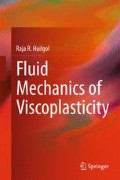Appendix
For the moment, assume that the total stress tensor \(\mathbf{T} = - p\mathbf{1} + \mathbf{S}\), where \(p\) is the pressure and \(\mathbf{S}\) is the extra stress tensor. The equations of motion (3.2.9) become
$$\begin{aligned} - \nabla p + \nabla \cdot \mathbf{S} + \rho \mathbf{b} = \rho \mathbf{a}, \end{aligned}$$
(A3.1)
which have the following indicial form:
$$\begin{aligned} -p_{,i} + S_{ij;j} + \rho b_i = \rho a_i,\quad i , j = 1, 2, 3, \end{aligned}$$
(A3.2)
in curvilinear coordinates. In (A3.2), \(S_{ij}, p_{,i}, b_i\) and \(a_i\) are the covariant components of the extra stress tensor, the pressure gradient vector, the body force vector and the acceleration vector respectively and the semi-colon (;) denotes the covariant derivative. The set of three equations in (A3.2) have to be cast in their respective physical component forms when problems in cylindrical or spherical coordinates have to be solved. For a complete coverage of these matters, see [1]. We list below the equations in Cartesian, cylindrical and spherical coordinates which are employed, as necessary, in the sequel.
Cartesian Coordinates
$$\begin{aligned} - {\frac{\partial p}{\partial x}} + {\frac{\partial S_{xx}}{\partial x }} + {\frac{\partial S_{xy}}{\partial y}} + {\frac{\partial S_{xz}}{\partial z}} + \rho b_x = \rho \bigg ({\frac{\partial u}{\partial t}} + u{\frac{\partial u}{\partial x}} + v{\frac{\partial u}{\partial y}} + w{\frac{\partial u}{\partial z}}\bigg ), \end{aligned}$$
(A3.3)
$$\begin{aligned} - {\frac{\partial p}{\partial y}} + {\frac{\partial S_{xy}}{\partial x}} + {\frac{\partial S_{yy}}{\partial y}} +{\frac{\partial S_{yz}}{\partial z}} + \rho b_y = \rho \bigg ({\frac{\partial v}{\partial t}} + u{\frac{\partial v}{\partial x}} + v{\frac{\partial v}{\partial y}} + w{\frac{\partial v}{\partial z}}\bigg ), \end{aligned}$$
(A3.4)
$$\begin{aligned} \quad \,\, - {\frac{\partial p}{\partial z}} + {\frac{\partial S_{xz}}{\partial x}} + {\frac{\partial S_{yz}}{\partial y}} + {\frac{\partial S_{zz}}{\partial z}} + \rho b_z = \rho \bigg ({\frac{\partial w}{\partial t }} + u{\frac{\partial w}{\partial x}} + v{\frac{\partial w}{\partial y}} + w{\frac{\partial w}{\partial z}}\bigg ). \end{aligned}$$
(A3.5)
Cylindrical Coordinates
$$\begin{aligned} - {\frac{\partial p}{\partial r}}&+ {\frac{\partial S_{rr}}{\partial r}} + {\frac{1}{r}}{\frac{\partial S_{r\theta }}{\partial \theta }} + {\frac{\partial S_{rz}}{\partial z}} + {\frac{S_{rr} - S_{\theta \theta }}{r}} + \rho b_r \nonumber \\&= \rho \bigg ({\frac{\partial u}{\partial t}} + u{\frac{\partial u}{\partial r}} + {\frac{v}{r}}{\frac{\partial u}{\partial \theta }} + w{\frac{\partial u}{\partial z}} - {\frac{v^2}{r}}\bigg ), \end{aligned}$$
(A3.6)
$$\begin{aligned} - {\frac{1}{r}}{\frac{\partial p}{\partial \theta }}&+ {\frac{\partial S_{r\theta }}{\partial r}} + {\frac{1}{r}}{\frac{\partial S_{\theta \theta }}{\partial \theta }} + {\frac{\partial S_{\theta z}}{\partial z }} + {\frac{2}{r}} S_{r \theta } + \rho b_\theta \\&= \rho \bigg ({\frac{\partial v}{\partial t}} + u{\frac{\partial v}{\partial r}} + {\frac{v}{r}}{\frac{\partial v}{\partial \theta }} + w{\frac{\partial v}{\partial z}} + {\frac{uv}{r}}\bigg ), \end{aligned}$$
(A3.7)
$$\begin{aligned} - {\frac{\partial p}{\partial z}}&+ {\frac{\partial S_{rz}}{\partial r }} + {\frac{1}{r}}{\frac{\partial S_{\theta z}}{\partial \theta }} + {\frac{\partial S_{zz}}{\partial z }} + {\frac{1}{r}} S_{rz} + \rho b_z \\&= \rho \bigg ({\frac{\partial w}{\partial t }} + u{\frac{\partial w}{\partial r}} + {\frac{v}{r}}{\frac{\partial w}{\partial \theta }} + w{\frac{\partial w}{\partial z}}\bigg ). \end{aligned}$$
(A3.8)
Spherical Coordinates
$$\begin{aligned} - {\frac{\partial p}{\partial r}}&+ {\frac{\partial S_{rr}}{\partial r }} + {\frac{1}{r}}{\frac{\partial S_{r\theta }}{\partial \theta }} + {\frac{1}{r\sin \theta }}{\frac{S_{r \phi }}{\partial \phi }} + {\frac{1}{r}}[2 S_{rr} - S_{\theta \theta } - S_{\phi \phi } + \cot \theta \ S_{r\theta }] + \rho b_r \\&= \rho \bigg ({\frac{\partial u}{\partial t }} + u{\frac{\partial u}{\partial r}}+ {\frac{v}{r}}{\frac{\partial u}{\partial \theta }} + {\frac{w}{r \sin \theta }}{\frac{\partial u}{\partial \phi }} - {\frac{v^2 + w^2}{r}}\bigg ), \end{aligned}$$
(A3.9)
$$\begin{aligned} -{\frac{1}{r}}{\frac{\partial p}{\partial \theta }}&+ {\frac{\partial S_{r\theta }}{\partial r}} + {\frac{1}{r}}{\frac{\partial S_{\theta \theta }}{\partial \theta }} + {\frac{1}{r\sin \theta }}{\frac{S_{\theta \phi }}{\partial \phi }} + {\frac{1}{r}}[3 S_{r \theta } + \cot \theta (S_{\theta \theta } - S_{\phi \phi })] + \rho b_\theta \\&= \rho \bigg ({\frac{\partial v}{\partial t }} + u{\frac{\partial v}{\partial r}} + {\frac{v}{r}}{\frac{\partial v}{\partial \theta }} + {\frac{w}{r \sin \theta }}{\frac{\partial v}{\partial \phi }} + {\frac{uv}{r}} - {\frac{w^2 \cot \theta }{r}}\bigg ), \end{aligned}$$
(A3.10)
$$\begin{aligned} - {\frac{1}{r \sin \theta }}{\frac{\partial p}{\partial \phi }}&+ {\frac{\partial S_{r\phi }}{\partial r }} + {\frac{1}{r}}{\frac{\partial S_{\theta \phi }}{\partial \theta }} + {\frac{1}{r\sin \theta }}{\frac{S_{\phi \phi }}{\partial \phi }} + {\frac{1}{r}} [3 S_{r\phi } + 2 \cot \theta \ S_{\theta \phi }] + \rho b_\phi \\&= \rho \bigg ({\frac{\partial w}{\partial t }} + u{\frac{\partial w}{\partial r}} + {\frac{v}{r}}{\frac{\partial w}{\partial \theta }} + {\frac{w}{r \sin \theta }}{\frac{\partial w}{\partial \phi }} + {\frac{uw}{r}} + {\frac{vw \cot \theta }{r}}\bigg ). \end{aligned}$$
(A3.11)
Typically, in fluid mechanics, the body force is assumed to be derived from a potential \(\chi ,\) or it is zero. In the former case, \(\mathbf{b} = - \nabla \chi \) so that we have to solve the equations
$$\begin{aligned} - \nabla p + \nabla \cdot \mathbf{S} = \rho \mathbf{a}, \end{aligned}$$
(A3.12)
where \(p\) includes the \(\rho \chi \) term. Of course, when the body force is zero, we have to examine
$$\begin{aligned} - \nabla p + \nabla \cdot \mathbf{S} = \rho \mathbf{a}. \end{aligned}$$
(A3.13)

